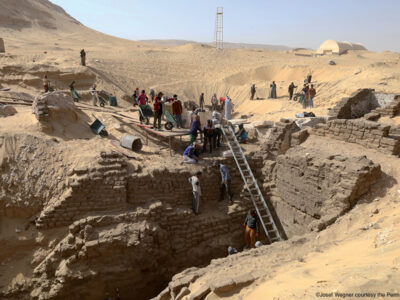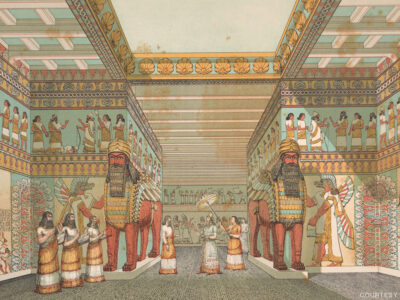WHILE the media have been digging into Thomas Jefferson’s sexual history based on recent DNA analysis, a Penn alumna has been busy uncovering real dirt on our nation’s third president — the dirt from his lawn, that is. The soil in question is not located at Monticello, but a lesser-known home, some 90 miles to the south, which reveals a more private side of the author of The Declaration of Independence. It was Poplar Forest, a 4,800-acre plantation outside Lynchburg, Va., where Jefferson designed and built his own retirement villa retreat — a place where he could enjoy what he called “the solitude of a hermit.”
Dr. Barbara Heath, G’83, Gr’88, Poplar Forest’s director of archaeology since 1992, has been working to restore the landscaping to its original elaborate design (inspired by 18th-century French and English gardens) while excavating for clues about the lives of Jefferson and the slaves who labored on the plantation. “I think [Poplar Forest] shows a lot about Jefferson as a private citizen. It shows him also as an older adult,” Heath says. “Monticello had become a very public showplace. He was trying to make a very public statement about architecture and furnishings, and hospitality. He built Poplar Forest as his own retreat. He didn’t invite many people to come here.”
These clues to Jefferson’s history had been lost for well over a century. Soon after his death in 1826, the property passed out of his family’s hands, was burned in a fire, and was privately owned until a non-profit group purchased it in 1984 in order to restore it. The exterior of Jefferson’s dwelling, an octagonal brick house built according to his meticulous specifications, was finally reconstructed last summer. Interior work began in the fall.
“I didn’t start off with a fascination with Jefferson,” explains Heath, who previously worked at Monticello. “I started off really interested in looking at plantations and looking at slavery.” She earned her bachelor’s degree in anthropology and Spanish at The College of William & Mary, and her master’s and Ph.D. in American civilization at Penn,
where she recalls being influenced by classes on slavery and the American
South taught by Dr. Drew Faust, Annenberg Professor of History, and Dr.
Robert Schuyler, associate professor of anthropology. Once Heath began
working at Monticello, first as a field supervisor, and then as acting
director of archaeology, she says, “I realized there was a lifetime’s
worth of questions that I could ask about him.”
Lacking landscape drawings for Poplar Forest, her team
has pored over written instructions from Jefferson to his overseers on
what kinds of shrubs and trees he wanted planted. Using those records,
they’ve been excavating the south lawn to determine their exact locations,
finding “really wonderful evidence” from the soil composition
in each layer. Heath hopes to finish up the lawn excavation and then devise
a planting plan to recreate Jefferson’s original landscaping.
Remains of slave housing found on the property so far
date back to 1770 and 1790, before Jefferson built his house. Artifacts
discovered at those sites — ceramic cookware, beads, buckles, and even
keys and padlocks — raise interesting questions about privacy and ownership
among the slaves. Other historians have found that slaves did have access
to cash and bartering, Heath says. Historical records at Monticello show
that Jefferson paid his slaves and overseers for things like poultry-raising
and dirt-moving, so it’s possible, Heath says, that similar transactions
could have taken place at Poplar Forest.
Heath’s excavation team also found some unusual stone
tobacco pipes that appear to have been made by the slaves. “Those
were really neat. They gave us a sense of what people do with their spare
time, and they’re also decorated with sort of etched-in lines, some crosses,
and some stems of the pipes are shaped like octagons, so you get a sense
of their aesthetic.” She would also like to locate slave quarters
that were lived in while Jefferson was a regular visitor, “to find
out how his being there affected the lives on the property.”
Poplar Forest (www.poplarforest.org), though a work
in progress, is open to tourists from April to November and received about
25,000 visitors last year. “We’re not trying to become another Monticello,
but to try to reach a wider audience, to let people know about the other
side of Jefferson.”
It would seem that many people are curious about the
multifaceted nature of Jefferson, given the recent debates spawned by
DNA analysis linking him to descendants of his slave Sally Hemings. Poplar
Forest does have its own Hemings connection, albeit one that’s less likely
to grab headlines: Sally Heming’s brother, John, was a carpenter who helped
build the house.
Tuesday, July 8, 2025
Popular
Administration
Anniversary
Archaeology
Architecture
Art
Awards
Books
Calendar
Campus Life
Commencement
Education
Elsewhere
entrepreneurs
Events
Exhibition
Expert Opinion
Faculty
Film
Football
Gifts
Health
Healthcare
Heard on Campus
History
International
Leadership
Medicine
Men's Basketball
Music
notes
obits
painting
Penn Medicine
Penn Museum
Philadelphia
Photography
Poetry
Politics
Science
Student Life
Technology
Television
Theater
Wharton
Window




